Tip #1475: Recreating 1859 Harpers Ferry
… for Visual Effects
Tip #1475: Recreating 1859 Harpers Ferry
Larry Jordan – LarryJordan.com
Interviews with the VFX team for “The Good Lord Bird.”


This article, written by Chris McGowan, first appeared in VFXVoice.com. This is an excerpt.
NOTE: Here’s the link
For the Showtime series “The Good Lord Bird,” show-side Visual Effects Supervisor Brad Minnich and Ingenuity Studios Visual Effects Supervisor Andrew Woolley were tasked with recreating Harpers Ferry in 1859 and other settings from the last years of abolitionist John Brown.
Matthew Poliquin was Executive Producer and Adam Lambert the VFX Producer for Ingenuity Studios. Marz VFX, Barnstorm VFX, Trehmer Film and Technicolor VFX were other participating visual effects studios. Ingenuity Studios, the primary VFX house, completed 450 shots and worked on everything from period towns and landscapes to CGI fires, muzzle flashes, train smoke, extensive matte paintings and CG body doubles in battle.
“We had a lot of on-set photography and drone footage to reference to build that town,” Minnich comments. A lot of older photography from the area was also used for reference of what the structures and landscape looked like. “The cool thing about Harpers Ferry is that it is still intact and still has the [pre-Civil War] essence. I remember a session with Andrew where we picked off the modern buildings.” With those cleared out, “Andrew and his team at Ingenuity Studios had a good guide.”
Harpers Ferry is in a river valley, with mountains on either side. One of the memorable establishing scenes is a great reveal of the region. A horse and wagon and grassy field are in the foreground of the shot. Right behind them, production rigged a bluescreen. Ingenuity Studios created everything beyond the foreground elements. “We had to find or build all the elements – trees and grasses, mountains and so on, in the correct varietals and topography for the location,” Woolley notes. Another item was a bridge built in CG and added to the scene. “We had to match all the lighting to the practical elements in the scene,” he adds. “We stitched everything together and projected it onto some rough geo to give more 3D feel. It’s essentially 2.5D, though where the various depths move independently to achieve the correct parallax through the crane move. Finally, it was all integrated with atmosphere and the sky replacement to cap it off. It was the big reveal of Harpers Ferry. Once we locked that in, it established the lay of the land for our viewers.”
EXTRA CREDIT
The article continues with more interviews, along with before and after images of various effects shots.


Leave a Reply
Want to join the discussion?Feel free to contribute!